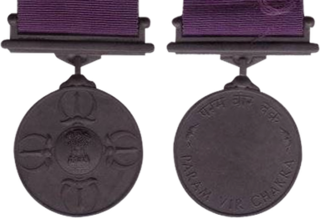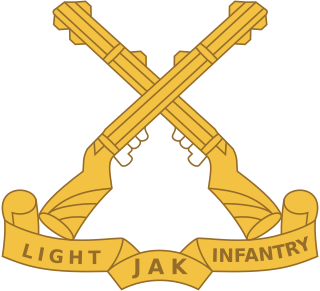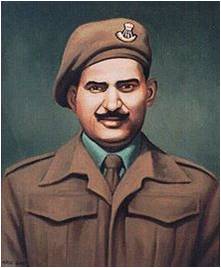
The Indo-Pakistani war of 1947–1948, also known as the first Kashmir war, was a war fought between India and Pakistan over the princely state of Jammu and Kashmir from 1947 to 1948. It was the first of four Indo-Pakistani wars between the two newly independent nations. Pakistan precipitated the war a few weeks after its independence by launching tribal lashkar (militias) from Waziristan, in an effort to capture Kashmir and to preempt the possibility of its ruler joining India.

The Param Vir Chakra (PVC) is India's highest military decoration, awarded for displaying distinguished acts of valour during wartime. Param Vir Chakra translates as the "Wheel of the Ultimate Brave", and the award is granted for "most conspicuous bravery in the presence of the enemy". As of January 2018, the medal has been awarded 21 times, of which 14 were posthumous and 16 arose from actions in Indo-Pakistani conflicts. Of the 21 awardees, 20 have been from the Indian Army and one has been from the Indian Air Force. Major Somnath Sharma was the first recipient. A number of state governments of India as well as ministries of the central government provide allowances and rewards to recipients of the PVC.

The 11 Gorkha Rifles is a Gorkha regiment of the Indian Army that was re-raised after independence. The regiment consists of primarily the Kirant Tribes Rai, Limbu, Yakkha, Sunuwar of Eastern Nepal, Darjeeling, Kalimpong, Dooars of West Bengal, Sikkim and other parts of Northeast India. Though it is considered to be the youngest of the Gorkha regiments its lineage is as long as those of the 7th Gurkha Rifles and 10th Gurkha Rifles.

The Parachute Regiment is an airborne and special forces regiment of the Indian Army. It was raised in 1945 as part of the British Indian Army but was disbanded after World War II and was re-raised in 1952 as part of the Indian Army. Currently it consists of fifteen Special Forces, two Territorial Army and one Rashtriya Rifles battalions.

The Kumaon Regiment is one of the oldest infantry regiments of the Indian Army. The regiment traces its origins to the 18th century and has fought in every major campaign of the British Indian Army and the Indian Army, including the two world wars, and is one of the highest decorated regiments of the Indian Army.

Flying Officer Nirmal Jit Singh Sekhon, PVC was an officer of the Indian Air Force. He was posthumously awarded the Param Vir Chakra, India's highest military decoration during war time, in recognition of his lone defence of Srinagar Air Base against a Pakistan Air Force (PAF) air raid during the Indo-Pakistani War of 1971. He is the only member of the Indian Air Force to be honoured with the PVC.

The Jammu and Kashmir Light Infantry is an infantry regiment of the Indian Army. The regimental center is in Srinagar's Airport Complex at Awantipora with a winter setup near Jammu. Its regimental insignia consists of a pair of crossed rifles. The regiment mostly consists of volunteers from the state of Jammu & Kashmir and ethnic groups from the state. The Jammu and Kashmir Light Infantry is considered to be one of the most decorated regiment of the Indian army having won 1 Param Veer Chakra and 3 Ashok Chakra. Naib Subedar Chuni Lal of the 8th battalion Jammu and Kashmir Light Infantry is one of the most decorated personnel of the Indian Army.
Savitri Bai Khanolkar was a Swiss-Indian designer, best known for designing the Param Vir Chakra, India's highest military decoration, awarded for displaying distinguished acts of valour during wartime. Khanolkar also designed several other major gallantry medals including the Ashok Chakra (AC), Maha Vir Chakra (MVC), Kirti Chakra (KC), Vir Chakra (VrC) and Shaurya Chakra (SC). She had also designed the General Service Medal 1947, which was used until 1965. Khanolkar was also a painter and an artist.

The Rajput Regiment is one of the oldest infantry regiments of the Indian Army, originating in 1778 with the raising of the 24th Regiment of Bengal Native Infantry. The 1st battalion of the regiment was formed in 1798.

The Garhwal Rifles, formerly known as the Royal Garhwal Rifles, are an infantry regiment of the Indian Army. It was originally raised in 1887 as the 39th (Garhwal) Regiment of the Bengal Army. It then became part of the British Indian Army, and after the Independence of India, it was incorporated into the Indian Army.

Somnath Sharma, PVC, was an Indian military officer and the first recipient of India's highest military decoration, Param Vir Chakra (PVC), which he was awarded posthumously.

Sheikh Ul Alam International Airport or Srinagar Airport, also known as Budgam Airbase is an international airport serving Srinagar, the summer capital of the Indian union territory of Jammu and Kashmir. It is owned by the Indian Air Force with the Airports Authority of India operating a civil enclave at the airport and was designated as an international airport in 2005. The airport is located in Budgam, about 12 km (7.5 mi) south of Srinagar. It has an integrated domestic and international terminal with one asphalt runway.

Subedar and Honorary Captain Karam Singh PVC, MM was an Indian soldier and a recipient of the Param Vir Chakra (PVC), India's highest award for gallantry. Singh joined the army in 1941, and took part in the Burma Campaign of World War II, receiving the Military Medal for his actions during the Battle of the Admin Box in 1944. He also fought in the Indo-Pakistani War of 1947, and was awarded the PVC for his role in saving a forward post at Richhmar Gali, south of Tithwal. He was also one of the five soldiers chosen to raise the Indian flag for the first time after independence in 1947. Singh later rose to the rank of subedar, and was conferred the rank of honorary captain before his retirement in September 1969.

Company Havildar Major Piru Singh Shekhawat was an Indian Army non-commissioned officer, awarded the Param Vir Chakra (PVC), India's highest military decoration 3245.
Lieutenant Colonel Dewan Ranjit Rai, MVC was an Indian Army officer who played a key role during the Indo-Pakistani War of 1947. As the commanding officer of the 1st battalion, The Sikh Regiment, he was the first recipient of the Maha Vir Chakra, which was awarded posthumously.

Brigadier Rajinder Singh Jamwal, MVC, also remembered as the Saviour of Kashmir, was an officer in the Jammu and Kashmir State Forces. He briefly served as the Chief of Staff of State Forces and died fighting during the First Kashmir War. Rajinder Singh and his small contingent of about 200 men successfully delayed the advance of a much larger force of Pakistani tribal raiders near Uri for several days, during which the Maharaja of Kashmir acceded to India and the Indian forces air-lifted for the defence of Kashmir.

Khurshid Anwar was a member of Indian National Army and an activist of All-India Muslim League, heading its private militia, the Muslim League National Guard. Described as a "shadowy figure" and "complete adventurer", he is generally addressed as a "Major" in Pakistani sources. He was a key figure in the rise of the Muslim League during 1946–47, organising its campaigns in Punjab and North-West Frontier Province, prior to India's partition. After the independence of Pakistan, he was instrumental in organising the tribal invasion of Kashmir, leading to the Indo-Pakistani War of 1947.

Major General Ian Cardozo AVSM SM is a former Indian Army officer. He was the first war-disabled officer of the Indian Army to command a battalion and a brigade. He is an amputee due to a war injury.
Dadh is a village in the Bhawarna tehsil of Kangra district in Himachal Pradesh State, India.
The Battle of Shalateng was a military engagement on 7 November 1947, during the Indo-Pakistani war of 1947–1948. It was a decisive battle that resulted in the halting of the Pakistani offensive and the beginning of the Indian counter offensive.














